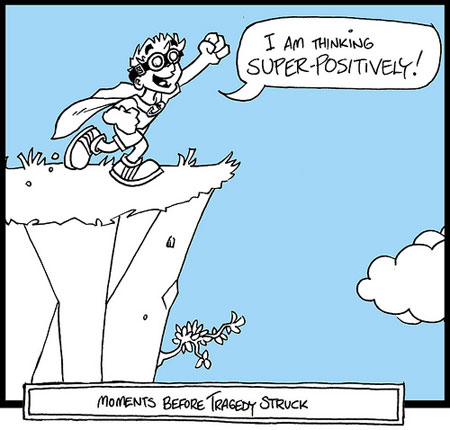Time and time again I read about the importance and power of being positive when it comes to not only work but life as well. They essentially preach that if you stay positive during a challenging time then it’s more likely to yield a positive result, and conversely, if you take a negative viewpoint the chances of failure are maximised.

While I’m not going to dispute this, I do feel this life lesson is often misunderstood and even abused in the workplace with the result being failure in the short-term, and in the long-term a very damaging self-perpetuating culture that actually hinders businesses everywhere by scaring employees into silence and creating a delusional mindset – or as described in the fascinating article by Jason Yip.
…a systemic inability to confront brutal reality.
Why does problem-hiding occur? Jason Yip
To bring it back to a digital project management level, I’m talking about a situation where a client or your colleagues give you what looks like an impossible digital project-based mountain to climb and when you begin to raise anything other than positive sugar coated comments you’re labelled as being negative.
I’ll say it now – I think this is utter BULLSHIT.
But hang on a minute, how do you know you’re not being negative? How do you know what’s being asked of you and your team is not feasible? How do you know by immediately taking this approach isn’t dooming the challenge to failure before you’ve even tried?
Negativity explored
The dictionary describes ‘negativity’ as:
Expressing, containing, or consisting of a negation, refusal, or denial – indicating opposition or resistance. Lacking positive or constructive features, unpleasant, disagreeable, gloomy, pessimistic.
The Free Dictionary
Pretty depressing huh, kind of makes you feel like the below made me feel as a child, FIGHT AGAINST THE SADNESS!
Horrific! If you want to take a few minutes to recover at this point I completely understand.
However, when it comes to digital project management I sincerely believe it is a Digital Project Manager’s job to execute most of the actions listed in the first sentence of the dictionary’s definition when necessary, and absolutely at all costs never any of those in the second – thus throwing the very essence of ‘what is negativity’ in digital projects into a spin.
It’s my belief that there are two types of people labelled as negative in digital agencies:
- A person who’s never positive about any digital project or agency strategies
- A person who’s realistic and isn’t afraid to speak up while others are afraid

For the purposes of this article I’m going to ignore the Type 1 people and leave them with their dehumanised droid-esque title but want to emphasis just how different these two types are.
The dangers of blind positive thinking
Before I get into why negativity isn’t always bad, let’s look at the benefits of blind positive thinking. I use this term to refer to the mentality adopted by some whereby no matter what the challenge they believe simply by being positive means they will prevail – an attitude commonly associated with entrepreneurs.
There is absolutely no doubt in my mind that adopting this mindset will see both you and teams working for you through tough times. It is infinitely nicer to work in an environment where everyone is positive rather than negative, it motivates people, it encourages people to excel beyond their previously self-imposed limits and, just like negativity it’s highly infectious.
But, and it’s a big but, at what point does positivity drift into the delusional? I’ll tell you when, it’s at the point where no amount of positive thinking in the whole wide world will revert a doomed situation into a successful one.
To focus 100% on positivity, to try to trick your brain into thinking everything is great, is to prevent yourself from making an impact in your life and in the world. When you turn a blind eye to what’s wrong in the world and what’s wrong in your life, you’ll never be able to do anything to fix it.
Joey Weber, The Case for Being Negative
Positive thinking will not fill your tank with gas when you’ve run out, nor will it get your £100k digital project complete for £10k – in steps the realist – or in the context of this article, the Digital Project Manager.
There will be points in a Digital Project Manager’s career where they have to be the ones to put a total shitter on everyone’s positive plans by getting annoying logical on their ass, some will call this being negative, but it isn’t, it’s just fact.
Sometimes you have to ram home the dangers of blind positive thinking and stop people from making huge mistakes on digital projects, but the method you choose to do this can seriously make or break your reputation as a Digital Project Manager – play it wrong and you’ll be labelled as negative and future sceptical stands will be ignored, play it right and over time your judgment will be trusted.
The confession
As with any lesson in digital project management I’ve ever learnt, I learnt it the hard way, by making mistake after mistake. For example, when being given completely unrealistic budgets or deadlines I’ve made a ‘you must be mental‘ face and pretty much said that.
I was told to stop being so negative and to get on running the digital project. I ran it to the best of my ability and of course it ran massively over schedule and budget. Was I right 99% of the time? You bet your sweet ass I was, but had I played this situation well? Hell no.
What I had done was de-motivate my boss, my team, myself and spent the whole project uttering bad things and occasionally getting accused of actually causing the overrun due to my negativity – total nonsense but also a total fail on my part.

So what exactly did these painful lessons teach me… they taught me how to communicate realism.
How to be negative (realistic)
Below are the lessons I’ve learnt when it comes to expressing huge concerns about digital projects. If only one or two Digital Project Managers out there can put these into practice and save themselves from some pain, I’ll be a happy little Englishman.
It’s not obvious to everyone
First of all, when I was pulling my ‘you must be mental’ face I was making the mistake of assuming that the ‘mission impossible demand’ was so obviously unachievable only a fool could think otherwise.
Later I realised this is not the case and that was actually my experience managing digital projects that meant I could see it immediately from a proposal, an estimate or proposed timeline, where others could not.
Think before you speak
Before you pull your version of ‘the face’ take a few minutes to consider the very real possibility that it’s not common sense but actually your skill, your expertise and the very reason they hired you that make it so clear to see – even if you’re completely right, holding back from reacting quickly will save you oodles of pain.

Ignore your instinct, maybe it’s possible
Instead of immediately going toe-to-toe with a positive smiley person and ruin their mood and your reputation, start by being humble and consider the fact that your instincts may be wrong.
Approach the problem logically i.e. take all of the requirements, break them down into smaller chunks and assign money, time or people to it on the absolute happy path where there is zero resistance and see if in fact you’re right.
Try your damndest to make it work on paper, and only when you’ve sincerely tried every trick in the digital project management book and still you find gaping holes can you start to take the next steps.
Don’t use your Opinion, use cold hard numbers
Once you’ve done all the calculations for the happy path, save it and format it in such a way that it cannot be disputed by anyone regardless of their sunny disposition. Although taking longer, this is the maths equivalent of the ‘are you mental’ face and is much more powerful, unless you’re Chuck Norris.

Offer a real solution, and get positive!
This is one of the most important lessons in digital project management, if not life… if you flat out disagree with something, don’t waste the limited time you have on this planet whining about it unless you’re willing to try and fix it.
As a Digital Project Manager, it’s your job to solve problems just as much as it is a designer’s or developer’s job.
Always follow the unveiling of your dream crushing numbers with either a proposed solution or a forum where a solution can be derived. Be it by adding more resource to a digital project, using clever workarounds to achieve the same goals, getting more money or phasing the solution.
But don’t stop there, do the numbers on this too. Get the digital project into a position where, even if it’s still going to be a mission, everyone, including you is able to get genuinely positive about it again!
The crux of the matter
Anyone who hides behind the mask of eternal and permanent positivity claiming that anyone who protests are all negative, aside from getting right on my tits, need a swift kick up the behind.
There is a very real difference between being negative and being realistic.
A negative person is rarely positive, a realistic person is sometimes positive and sometimes not, but when not, always tries to get things into a state where they can feel positive about it as opposed to constantly ‘thinking positive’ and screwing up time and time again.
Being realistic does not mean limiting your dreams; it simply means you make sensible steps to reaching them.
To be realistic is to think about things that you feel are really possible to achieve.
Difference Between Negative and Realism










Great read Sam, another interesting article! :) (happy face denotes delusion)
For me, the perception of someone’s outlook, be that positive or negative, is relative to ones own demeanour. A positive person would view a realistic person as negative. A negative person views anyone positive as delusional.
This perception however, is just the by-product of not understanding alternative personality types.
People will fall somewhere on the spectrum of ‘detailed people’ to ‘big picture people’. They are two very different beasts, and they will view each other as being either ‘unnecessarily negative’ or ‘blindly positive’. Truth is, neither is bad, in fact they both need to co-exist in order for success to prevail. Two positive people working together will suffer from detail blindness, and two negative people working together would never do anything for fear of failing.
‘Detail’ people are the realistic people, they’re not visionaries or big thinkers – but they do see the hidden ‘gotchas’ that a ‘big picture’ (positive) person would miss. It’s this misunderstanding and lack of appreciation of differing personality types that causes many of the frustrations and frictions highlighted in the article. Simply understanding that both personality types exist for very good reason would make life easier for everyone. ‘Big Picture’ people need to understand that ‘detail’ people are hired because they are there to spot the hidden ‘gotchas’ that would go unseen. ‘Detail’ people on the other hand need to understand that visionaries get things done because they are not bogged down with the details and look for opportunities rather than problems.
That said, negative and positive personalities do exist as well, I think you highlighted that quite well when you noted the difference of approach between a ‘WTF Face’ as opposed to taking the time to research the situation and respond with a more structured argument.
To know if you are truly a negative or positive person however, ask how you usually react to a new idea that on first inspection, seems unrealistic, do you say..
“I can add value by thinking about how best to make it work”
or
“I can add value by highlighting why this won’t work”
The first response is a positive one, and forms a positive frame of mind, that when applied, will find a way to improve the situation. The project may still go over budget, but at least some improvements were made and the PM genuinely added value by using their skill and knowledge to improve the project’s execution.
The second response, which on the surface may seem just as valuable, doesn’t actually help anyone. The mind is already in a negative space, and one is only looking for potential problems, not solutions. Highlighting a problem doesn’t help, working out a solution does.
Don’t get me wrong, any manager or client that says ‘I want solutions not problems’ should be shot by the cliche police – but all they are really trying to say is ‘I know you’re only being realistic, but try and look at it positively, rather than negatively’.
Blind optimism drives innovation and pushes us all forward, if everyone just highlighted the problems and pointed out why big ideas would never work, then the umbrella-hat would never exist, and that’s a sad sad world.
@Ads, haha an AMAZING reply!!! :)
You’re bang on about perception, it’s a great counter argument and perfect to have the opposing view in the same post, wish I had this for all my posts.
I can only testify to the ‘realistic’ point of view and know that we don’t view anyone who’s positive as delusional all the time, just sometimes – that’s a big difference, but a revealing insight into how positives view realists.
But the personality point is still valid. Looking at the big picture vs. the detail person, again I agree. I would bet few successful companies are headed up by the detail people, but as you say, I bet most of the leaders have a few detail people behind them pointing out the gotchas – the recipe for success being possibly a bit of good ole ying and yang!?
Knowing how to interact with different personalities is key and something I’ve learnt along the way for sure, and no doubt still have a lot of learning to do. At one of the companies I worked at we went through some of that psycho-analytic testing to determine what kind of person we were, and also how we could interact with other types – it was humbling and amazingly accurate.
As for the example question you gave to answer if you’re positive or negative however, this I completely disagree with and think it’s also quite revealing.
I genuinely don’t believe anyone ever thinks they can add value by highlighting why something won’t work, nor do they specifically look for problems in any situation just for kicks, but I believe this is unfortunately how some people think about realists, but speaking from the horse’s mouth I can confidently say this is flat out wrong.
I think a realist will always take the first approach, but often aren’t given the opportunity to offer a workable solution as this can take time. Like the ‘big thinkers’, the realist sometimes has to go on pure gut instinct and speak out – but it’s how these words are spoken by the realist, and also how they’re received by the positive that can make for a solution creating environment, or a toxic negative environment.
The realist needs to refine how he talks to a positive e.g. rather than “this won’t work” try “could I go away and look at the numbers on this one before we commit?”, and the positive needs to not go immediately on the defensive labelling well intentioned realism as negativity, but give opportunities and support to allow for solutions to be prepared.
I do however agree with you on the relationship between negativity and fear of failure, but I’ve learnt over the years that the fear of failure can be massively exacerbated by environment and / or how an individual is made to feel. I’ve been in what I would consider both good and bad environments and it’s quite shocking how my own positivity / realism / negativity varied in these different environments.
If there is a negative working environment with excessive amounts of in-fighting, cliques, back-biting, politics and where failure is frowned upon, many will grow a larger fear of failure than they naturally have and become very defensive.
But if people are fostered in an environment where failure and mistakes made, while trying to meet a challenging objective (I’m not defending incompetence here), is not met with a smack down, behind the scenes sniping or the blame game – then those more risk averse people tend to become a bit braver, more confident and ultimately start to take on bigger challenges with a better frame of mind than before.
Only when you experience a variety of environments does this become clear. Until experiencing this variety it’s so easy to assume things are one way or another and never revise your opinions.
I think another key points is that the ‘big thinkers’ usually run the show, backed up by realistic people. If the boss stays ‘positive’ and goes for a mission but fails, he or she only has to answer to themselves, but if the person working for them takes a positive gamble and loses, they have to answer to the boss – some bosses manage this situation well, some don’t – not always malicious but I think most genuinely forget what it’s like to actually have a boss and how this affects perspectives and approaches when it comes to ‘going for it’.
If the boss, or any of the bosses, use failure of a at a challenge as a chance to attack quality of work, this is a surefire way to ensure a realistic person remains hesitant to be brave and the self-perpetuating cycle begins that’s bad for both company and person.
Hearing these two extremes I think it boils down the ability to appreciate other people’s perspectives, the willingness to revise ‘labels’ and working on communication between different personalities.
I think we’re saying the same thing. I agree, a realist would hopefully always say the first statement, but a negative person would say the second.
Your original point was that it is wrong for a positive person to simply assume all realists are negative, which does happen and I’ve been guilty of that myself. I was using the statements as an example to know if someone is generally being negative, as opposed to simply being realistic about the situation.
There are people that will point out the short-falls before considering how to improve the situation – this is a negative approach rather than a realistic one. Genuine negative people do exist – I think it would be naive to assume they are simply realists.
Good point about ‘big thinkers’ are always backed up by realistic people. Take Alan Sugar – he knows he’s shite at the detail and that his big thinking would be dangerous without grounding, which is why he has his two side-kicks to tell it to him straight when he needs it. The trio thus form a perfect and balanced team.
Very interesting note about the environment, I hadn’t previously considered that it’s a lot easier to be positive if your ass isn’t on the line if it all goes south. Any big thinker will undoubtedly make just as many mistakes as good decisions. However if a PM / Employee had operated that ratio, they wouldn’t last long. So it may just be a case that the environment forces a stronger sense of realism because the margin for acceptable error is so much smaller.
Nice post. I also like to look at it as:
a good project manager clearly sees how things ARE and not just how they SHOULD BE.
Also, as you mention, even in pointing out the negative, it really does turn into more of a positive since the good project manager is also creating solutions (and not just complaining about things).
@David, thanks! Of course I agree with you but as Adam pointed out it’s takes a combination of people and personalities to make for a successful operation.
On creating solutions, again I agree completely, but the real trick is to carve out a situation where you’re able to do so. In my past I’d slam the door shut so early I wasn’t given the opportunity to provide a solution. I’ve since learnt to bite my lip a little bit, but not every instance allows even for this – tricky waters indeed!
As always, your articles are great. I really need to work more on my “realistic” face!
@Ani, thanks so much! It’s not an easy face to master I fully confess.